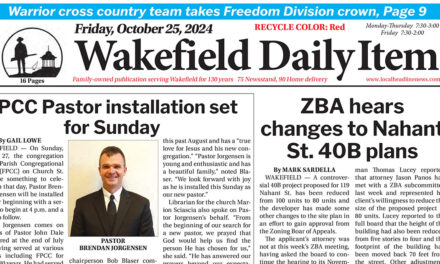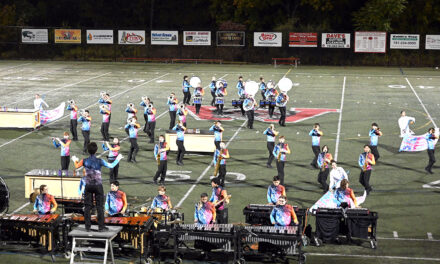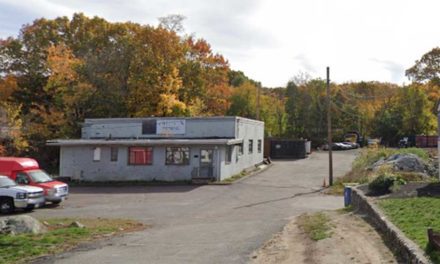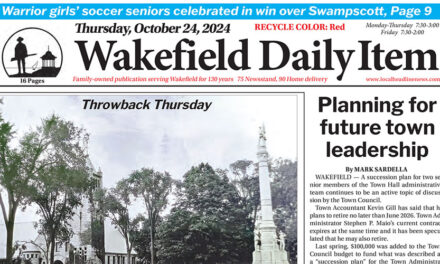Published in the April 22, 2019 edition.
By MARK SARDELLA
WAKEFIELD — A live local cable TV program that aired last week was billed as “Public Forum on Ballot Question 1.” But at times, it devolved into a heated debate with each side questioning the other’s backing and available resources to conduct their respective campaigns.
On tomorrow’s Town Election ballot, there are a number of changes to the Town Charter proposed by the Charter Review Committee. All of those changes were approved by Town Meeting last fall.
But the one that has generated by far the most interest is Question 1.
If passed, Question 1 would make changes to the process for calling a referendum election to overturn Town Meeting votes. Instead of the current process of filing a petition signed by 200 voters within 10 business days after the end of Town Meeting, persons wishing to call a referendum would have to file a petition signed by at least 2½ percent of the registered voters in town within 12 calendar days after the end of Town Meeting. Based on the town’s approximately 18,500 registered voters, that would raise the signature threshold to about 460 for calling a referendum election to overturn a Town Meeting vote.
Last week’s televised forum featured a panel including Chairman John Carney and Stacy Constas of the Charter Review Committee, plus moderator David Watts, Jr. arguing in favor of raising the threshold to 2½ percent of the total number of registered voters. A handful of citizens attending in the WCAT studio audience spoke on both sides of the issue.
Charles McCauley of Lawrence Street got the discussion rolling when he asked the Charter Committee members to explain their rationale for proposing the Charter change.
Carney explained that the Town Charter requires that every 10 years a committee review the Charter for possible changes. He said that people applied to be on the Charter Review Committee from a broad cross-section of citizens.
He said that many people contacted the Charter Review Committee about a range of concerns, “including how Town Meeting works.”
Carney said that the Charter Review Committee took that input from citizens and stakeholders and members formed their own opinions.
He said that one of the things that the Charter Committee was concerned about was that people would not want to go to Town Meeting due to the ease with which a small group of people could override a Town Meeting vote by gathering 200 signatures to force a Special Election.
“We want decisions at Town Meeting to mean something,” he said. Carney noted that a compromise was reached at Town Meeting last fall to reduce the threshold to 2½ percent rather than the 5 percent originally proposed by the Charter Committee.
Constas added that the Charter Committee felt that the current 200 signature threshold allowed for a “tyranny of the minority” to hijack the pure democracy of Town Meeting. She argued that the lower threshold allows a group to hide behind a dangerous, “monied special interest” to undermine the time and effort of those who attend Town Meeting.
She argued that the proposed increase in the number of required signatures was “very modest” and would still be the lowest of any community in the area.
She said that the Charter Committee was also concerned with the ease with which misleading information could be promulgated on social media to the detriment of the face-to-face fact-check of Town Meeting.
But McCauley questioned the timing of the move to increase the signature threshold. He maintained that it only came after a critical Town Meeting vote to fund the rebuilding of the Public Safety Building was overturned. He argued that changing the Town Charter was akin to changing the United States Constitution, and such changes should not be undertaken lightly.
Robert Mitchell of Spaulding Street argued that the town, with all its resources and months to prepare, only got 181 voters at Town Meeting in favor of increasing the signature total for referendum elections. (Actually, the vote at Town Meeting was 148-43 in favor.) Mitchell suggested that the town was now asking that a group of citizens gather several times that number of signatures in a much shorter time frame.
Carney countered that the Charter Committee did not have any “resources” to do mailings and robocalls as the group that overturned the Public safety Building vote did. He added that the people who go to the polls to vote to overturn a Town Meeting vote tend to be less informed than those who sit through the presentations and discussions at Town Meeting.
“We are not spending money to campaign,” Carney said to Mitchell. “Your group is.” Carney further asserted that the group that is funding opposition to the Charter change has not publicly identified itself.
Mitchell noted that any campaign group is required to file with the Town Clerk’s office and identify sources of funding.
(The Daily Item has obtained the filing for the group opposed to Question 1, which filed under the name “Stop Voter Suppression.” Bronwyn Della-Volpe of 8 Cyrus Street contributed $400. Robert Mitchell of 6 Spaulding Street kicked in $350. Patrick Bruno of 2 Mackenzie Lane contributed $200. Susan Randolph-Frey of 98 Cedar Street gave $200 and Eleanor Ixchel of 101 Broadway contributed $100. The total amount raised as of April 12 was $1,300.)
At one point in the discussion, David Watts, Jr. asserted that in 1999 the town had only 5,668 registered voters and 2.5 percent of that would have equaled 142. He further claimed that in 2009, there were 9,518 registered voters in town and 2.5 percent of those would have been 238. (Reporters
note:
In fact, there were 15,812 registered voters in Wakefield in 1999. In 2009, there were 16,692 registered voters in Wakefield. Source: Wakefield Town Reports.)
Robert McLaughlin of Water Street said that he researched all of the Town Meetings over the last 20 years. He found that of the 977 Town Meeting articles debated over that period only four or five had been the subject of referendum elections.
“I don’t consider that a reason to change the number of signatures,” he said. McLaughlin also disputed claims that it is “easy” to collect 200 signatures. He said that he had collected signatures for referendums to overturn a Town Meeting vote on two occasions.
“If you’re standing there with a clipboard,” he said, “people avoid you.”
Constas said that she has been told that misinformation has been dispensed by those collecting signatures seeking to overturn Town Meeting votes.
McLaughlin said that he took Constas’ claim “as a personal insult.”
Richard Greif of Kingmont Street said that he had personally been told misleading information by opponents of the Public Safety Building project, Brightview and the downtown parking garage.
Greif said that it was “important to protect the will of Town Meeting.” He added that stalling a project like the Public Safety Building only costs the town more money in the long run.
Town Councilor Tony Longo agreed. He said that costs of building projects like the Public safety Building go up about 4 percent every year that a project is delayed.
Greif also questioned the opponents’ use of the tag line “Stop Voter Suppression.”
“No one is being prevented from signing a petition or from voting,” he said. “I’m disappointed to hear that term used.”




